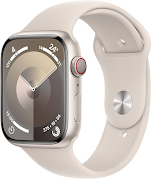If you’re eyeing the latest Apple Watch, chances are you've come across the Series 9 and the Series 9 Cellular. Both promise an array of features, but what sets them apart? Let's break it down:
1. Connectivity:
The key difference lies in their connectivity. The standard Series 9 relies on Bluetooth to connect to your iPhone for calls, messages, and data. On the other hand, the Series 9 Cellular can operate independently, letting you make calls, send texts, and stream music even if your iPhone isn’t nearby. However, there's a caveat with the Cellular version: it's region-locked for cellular functionality. If purchased in a specific country like India, it'll support carriers within India only for cellular service. Yet, it will still function as a non-cellular watch in other countries using Bluetooth.
2. Functionality:
Both models are packed with impressive features, tracking fitness, heart rate, and offering various workout modes. The Series 9 Cellular, with its standalone connectivity, can provide more comprehensive tracking during workouts without relying on your iPhone's proximity.
3. Music and Offline Capabilities:
The Series 9 Cellular lets you sync and stream Apple Music directly to your watch without your iPhone nearby, a boon for music lovers. Meanwhile, the standard Series 9 can store music locally when synced with your iPhone, allowing offline playback during workouts without streaming capabilities.
4. Aesthetic Difference:
Visually, the red circle on the crown distinguishes the Series 9 Cellular, giving it a unique look compared to the standard Series 9.
5. Battery Life:
Both models hold up well in terms of battery life, though frequent use of cellular features on the Series 9 Cellular might affect its longevity compared to the standard Series 9.
6. Price:
The Cellular version typically comes with a higher price tag due to its added capabilities, offering more independence from your iPhone.
Which One Should You Choose?
If independence from your iPhone and local cellular service compatibility are crucial, the Series 9 Cellular might be worth the extra investment. However, if you primarily need the core Apple Watch experience and can manage without cellular features outside your country, the standard Series 9 is a solid choice.
In Conclusion:
Choosing between the Apple Watch Series 9 and the Series 9 Cellular depends on your lifestyle and needs. Both models offer exceptional features, but the Cellular variant's regional cellular limitations need consideration, especially if frequent travel is part of your routine.
Whether you opt for the standard Series 9 or the Series 9 Cellular, you're getting a powerful device that seamlessly integrates into your daily life, keeping you connected, active, and organized in the most stylish way possible.
Apple Watch Series 9
- 45mm or 41mm case sizes
- Aluminum or stainless steel
- Speaker
- Microphone
Control:
- Digital Crown with haptic feedback
- Side button
- Double tap gesture
- On-Device Siri
Display:
- Always-On Retina LTPO OLED display
- Edge-to-edge display
- Ion-X front glass (Aluminium cases)
- Sapphire front crystal (Stainless steel cases)
- Up to 2,000 nits maximum brightness
- 1 nit minimum brightness
Chip:
- S9 SiP with 64-bit dual-core processor
- 4-core Apple Neural Engine
- 64GB capacity
Sensors:
- Blood oxygen sensor and app3
- Electrical heart sensor and ECG app4
- Third-generation optical heart sensor
- High and low heart rate notifications4
- Irregular rhythm notifications5
- Sleep stages
- Temperature sensing6
- Compass with Waypoints and Backtrack
- Always-on altimeter
- High-g accelerometer
- Ambient light sensor
Safety:
- Emergency SOS8
- International emergency calling9
- Crash Detection8
- Fall Detection8
Splash, Water and Dust:
- Water resistance 50m (swimproof)11
- Dust Resistance IP6X18
Connectivity and Communication:
- L1 GPS, GNSS, Galileo and BeiDou
- LTE and UMTS13
- Wi-Fi 4 (802.11n)
- Bluetooth 5.3
- Second-generation Ultra Wideband chip19
- GymKit
Power and Battery Life:
- Built-in rechargeable lithium-ion battery
- Up to 18 hours normal use15
- Up to 36 hours in Low Power Mode15
- USB-C magnetic fast-charging cable
Environmental Requirements:
- Operational temperature: 0°C to 35°C (32°F to 95°F)
- Non-operational storage temperature: −20°C to 45°C (4°F to 113°F)
- Relative humidity: 5% to 90% non‑condensing
- Operating Altitude: 0 m to 3,000 m (0 feet to 10,000 feet)
So, which one will be your wrist's new best friend?
Feel free to drop your thoughts in the comments section, and don't hesitate to request more engaging content and Q&A sessions on various tech & science topics! Your feedback helps us craft content you'll love.

